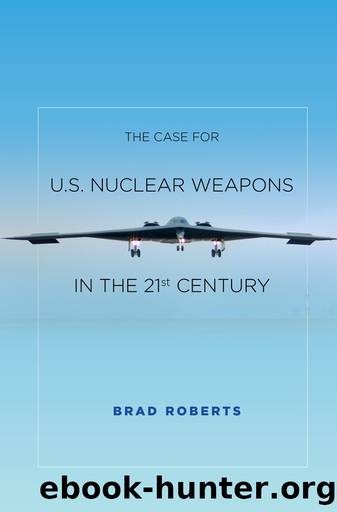The Case for U.S. Nuclear Weapons in the 21st Century by Brad Roberts

Author:Brad Roberts [Roberts, Brad]
Language: eng
Format: epub
Tags: Political Science, Security (National & International)
ISBN: 9780804797153
Google: PMC2CgAAQBAJ
Goodreads: 35191975
Publisher: Stanford Security Studies
Published: 2015-12-09T00:00:00+00:00
6
Extended Deterrence and Strategic Stability in Europe
ONE OF THE MOST STRIKING RESULTS OF THE END OF THE Cold War was the sudden disinterest in extended deterrence among American security specialists and among many allies as well. With the Presidential Nuclear Initiatives of 1991 and 1992, most of the U.S. nuclear weapons deployed abroad to protect and reassure allies were suddenly brought home and retired. The American strategic community went to work on other problems.
And one of the most striking results of nearly three decades of change since then is that extended deterrence has come back to center stage in American nuclear policy. In Northeast Asia, North Koreaâs emergence as a nuclear-armed power, along with Chinaâs ongoing military modernization, has raised fundamental new questions about the means and ends of U.S. extended deterrence policy. In Europe, Russiaâs new belligerence, along with instability in the Middle East, has renewed high-level interest in strengthening NATOâs deterrence and defense posture. Difficult choices lie ahead for the United States and its allies in these two regions. Some of them will involve highly sensitive questions of nuclear policy and posture.
This chapter and the following take up the new challenges of extended deterrence in these two regions, starting here with Europe. This chapter begins with a review of the key developments in the Euro-Atlantic security environment bearing on questions of extended deterrence. The NATO alliance has existed in a changed and changing security environment ever since the end of the Cold War, and in recent years there has been a rising debate about the impact of those changes on the allianceâs overall strategy and supporting deterrence and defense posture. Developments in both Russian policy and posture and the Middle East have driven this debate and in recent years have reinforced the alliesâ desire to strengthen deterrence.
The chapter then reviews recent efforts by the alliance to align its strategy with the new security environment and to update its deterrence and defense posture. In this process, both NATO and the Obama administration made a number of choices that surprised many outside commentators. This is especially true of the decision to maintain NATOâs unique nuclear sharing arrangements, which is described in detail here.
The chapter then considers the impacts of developments in Russiaâs policy and posture in 2014 on the implementation of NATOâs deterrence and defense review, including on the nuclear component. It concludes with an assessment of progress in strengthening deterrence in Europe and of implications for U.S. nuclear policy and posture and of challenges ahead.
But before turning to these tasks, this chapter begins with a definition of extended deterrence and a review of key associated policy issues.
Defining Extended Deterrence
Extended deterrence is a form of protection provided to an ally. Although deterrence can be extended to an ally by various means, the primary historical association has been with nuclear weaponsâhence the long-standing reference to the nuclear umbrella for U.S. allies. As Paul Huth has defined it, the purpose of extended deterrence is âto protect other countries and territories from attack, as distinct from preventing a direct attack on oneâs own national territory.
Download
This site does not store any files on its server. We only index and link to content provided by other sites. Please contact the content providers to delete copyright contents if any and email us, we'll remove relevant links or contents immediately.
| Biological & Chemical | Conventional |
| Nuclear |
The Radium Girls by Kate Moore(11921)
100 Deadly Skills by Clint Emerson(4840)
Rise and Kill First by Ronen Bergman(4701)
The Templars by Dan Jones(4627)
The Doomsday Machine by Daniel Ellsberg(4415)
The Rape of Nanking by Iris Chang(4136)
Killing England by Bill O'Reilly(3951)
Hitler in Los Angeles by Steven J. Ross(3900)
Stalin by Stephen Kotkin(3875)
12 Strong by Doug Stanton(3508)
Hitler's Monsters by Eric Kurlander(3268)
Blood and Sand by Alex Von Tunzelmann(3138)
The Code Book by Simon Singh(3073)
Darkest Hour by Anthony McCarten(3070)
The Art of War Visualized by Jessica Hagy(2943)
Hitler's Flying Saucers: A Guide to German Flying Discs of the Second World War by Stevens Henry(2714)
Babylon's Ark by Lawrence Anthony(2620)
The Second World Wars by Victor Davis Hanson(2480)
Tobruk by Peter Fitzsimons(2442)
